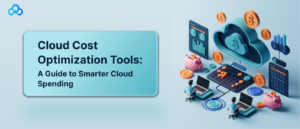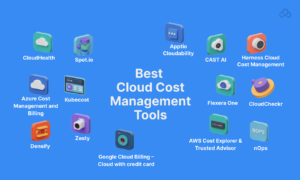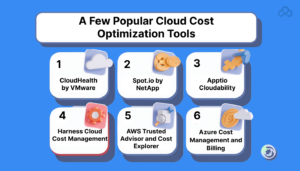Cloud Cost Optimization Tools: A Guide to Smarter Cloud Spending

Has your boss ever asked? How much did we spend on cloud this month? And boom! The number on the screen was a sad reality. Everyone knows that managing Cloud DevOps services is not a piece of cake or just a financial concern- it’s a business priority. In the age of digital transformation, cloud cost optimization tools are increasingly becoming an essential aspect to help organizations aware, business-centric decisions around their cloud investment.
Cloud cost optimization tools are platforms and services made to help organizations monitor, analyze, and manage their cloud usage effectively. Tools like these give insights on cloud spend analysis, automate cost-saving suggestions, and support policy enforcement to avoid extra budget.
In simple words, they help ensure you only pay for what you use and use what you pay for. Many industries switch to cloud-based infrastructure, but the challenge isn’t just about reducing costs but also understanding where and how that cost is being spent.
Why Real-Time Cloud Insights Are a Game-Changer for Scaling Businesses
Previously, companies were receiving a huge monthly cloud bill and trying to solve the charges using complex spreadsheets or manual processes. This often resulted in overspending, or underutilized resources. Today, businesses are using cloud savings platforms to break this pattern. Such tools offer visibility like- alerting, reporting, and forecasting features to stay ahead of potential waste and inefficiency.
Let’s take the case of a growing SaaS startup. As they reach heights, so is their AWS bill unfortunately. They used a cloud billing tool that tracked usage of servers across all teams and identified idle instances running during idle hours. With automation scripts triggered by schedules and usage thresholds, the startup reduced its monthly cloud cost by nearly 35% in just two quarters.
These savings are not just only about switching off a few servers and getting the things done. Cloud optimization is an industry shift. Companies using these tools build accountability across engineering, finance, and product teams. It encourages everyone to think about cost-efficiency alongside performance, uptime, and speed.
The main usage of these tools is right-sizing the resources. Businesses often over-provision resources “just in case,” leading to waste. Optimization tools analyze usage metrics and recommend smaller instance types or storage classes based on real needs. It’s a simple yet powerful way to reduce the wastage. A media company with a large video archive used such insights to move infrequently accessed content to low-cost archival storage, minimizing S3 spend by 50%.
One of the best features of cloud cost optimization tools is real-time cost visibility. In contrast to delayed billing reports these modern tools allow teams to view usage of data instantly. This is a fast response to unexpected spikes. For example, during a flash sale or product launch, teams can track compute and storage costs in real-time, ensuring usage doesn’t go beyond control.
How eCommerce Teams Use Cloud Tools to Manage Costs Smarter
Such tools help you to plan your finances in a better way while looking at the previous data, you can make really good assumptions about your future costs. This means you can set clear budgets for each team before-hand and avoid any last-minute surprises when bills show up. It also helps finance teams feel more confident about their plans.
A major e-commerce platform found success using predictive analytics from a cloud billing tool. During the holiday season, their tool anticipates traffic increases and cost implications, allowing IT teams to prepare infrastructure without oversupplying. As a result, they balanced high performance with controlled costs and improved margins.
Cloud cost optimization tools also support tagging policies. Tagging is the practice of labeling cloud resources with metadata such as project name, owner, environment, or cost center. This enables detailed cost allocation and transparency. For large organizations, accurate tagging ensures every department is billed for what they use, eliminating shadow IT and encouraging responsible usage.
Another major feature is automation and scheduling. Some tools can automatically shut down idle environments or scale resources up and down depending on demand. A devOps consulting and managed cloud services might schedule non-production environments to turn off at night and on weekends, leading to significant savings with zero manual intervention.
Also, cloud savings platforms help businesses leveraging the pricing models like reserved instances (RIs) and savings plans. These options give lower rates in exchange for longer-term commitments. Optimization tools track workloads to recommend which services qualify for such pricing models and calculate break-even points. This helps companies lock in savings without overpaying.
Companies That Have Implemented Cloud Cost Optimization
Tools

A Case Study: Netflix
Netflix, yes, you read right! The so-called Netflix and Chill, the cloud infrastructure of Netflix is to deliver high-quality streaming services. They built an in-house tool called Atlas for tracking and cost optimization. The system provides live feedback to engineering teams on their cloud usage, integrating with budgeting workflows.
By combining automation, metrics collection, and resource tagging, Netflix was able to reduce its cloud waste dramatically without compromising performance.
A Case Study: Intuit
The biggest financial software in the market uses a cloud optimization platform to help its multi-cloud setup. Their platform provides cost visibility down to individual developers. Teams have liberty to make their own infrastructure decisions with the cost visible impact.
This decentralized model of cost control has improved efficiency, accountability, and overall cost.
Another impact of cloud optimization tools lies in their integration capabilities. And these platforms work smoothly with AWS Cost Explorer, Azure Cost Management, Google Cloud Billing, and other cloud-native tools. It also integrates with business intelligence tools like Power BI or Looker, which allows businesses to combine cloud spend with customer behavior, marketing campaigns, or product updates as well.
A Case Study: Pinterest
Pinterest, the so -called pic inspo app for genz, uses cost optimization tools to manage its Google Cloud Service. With features like anomaly detection and auto-generated data, they can find underutilized GPU instances and storage volumes.
This led to a remake of their resource allocation strategy and netted a 25% cost reduction within six months.
A Few Popular Cloud Cost Optimization Tools

CloudHealth by VMware: Known for policy enforcement and multi-cloud support.
Spot.io by NetApp: Great for automating workload placement and utilizing spot instances.
Apptio Cloudability: This offers advanced forecasting, financial modeling, and chargeback features.
Harness Cloud Cost Management: It integrates directly with CI/CD pipelines for developer visibility.
AWS Trusted Advisor and Cost Explorer: This is native to AWS, useful for basic insights.
Azure Cost Management and Billing: Built-in cost control for Azure users.
Going forward, the future of cloud cost optimization will be conducted by AI and machine learning. Tools will not just alert about anomalies but also predict future spikes, suggest actions, and even implement changes automatically. This change toward proactive, intelligent cloud management will make it easier for organizations to stay within budget while maintaining flexibility.
There’s also growing interest in sustainability metrics. Cloud cost tools will soon manage energy usage and carbon emissions alongside cost. Businesses will not only optimize for dollars but also environmental impact, aligning cloud strategy with ESG goals.
Avoid Extra Costs by Using the Tools
Cloud cost optimization tools also enforce governance policies. Organizations can set usage thresholds, budget caps, and permissions to prevent overspending. These guardrails are essential for enterprises where multiple teams deploy resources independently. Setting up such controls helps avoid bill shock and ensures compliance with internal and external financial policies.
The ease of use of these tools also plays a big role in usability. Most platforms offer engaging dashboards, drill-down capabilities, and alert systems. This reduces reliance on technical specialists to interpret raw billing data.
Even non-technical managers can track costs and spot irregularities. This democratization of data access fosters a culture of cost ownership.
FAQs
1. What are cloud cost optimization tools?
Cloud cost optimization tools are platforms and apps that help businesses manage and reduce their cloud spending. They offer updated visibility into your cloud usage and help you find unused resources, and help you make smart suggestions on how to save money.
These tools go beyond basic cost tracking, and they support forecasting, automation, tagging, policy enforcement, and right-sizing of resources. In brief, they help make sure you are only paying for what you truly need.
2. Why is cloud cost optimization so important now?
Companies move to cloud infrastructure, cloud bills are booming fast and sometimes unpredictably. And monthly invoice is now a business-critical concern. Without visibility and control, it’s easy to overspend, miss budget targets, or waste resources.
Cloud cost optimization tools help solve this by giving teams from finance to engineering a clear view of cloud usage and cost drivers. With this insight, businesses can make smarter, faster decisions and stay within budget.
3. How do these tools help reduce cloud costs?
These tools use several smart features to cut down unnecessary expenses:
-
Real-time tracking: To know exactly where your cloud budget is going.
-
Automation: To shut down unused environments during idle.
-
Right-sizing: To get recommendations to use smaller and more efficient resources.
-
Forecasting: To predict future spending based on usage trends.
-
Policy controls: To set alerts and usage caps to avoid bill cost.
A SaaS startup saved 35% in just two quarters by finding idle instances and automating shutdowns during non-peak hours. This type of cost control wouldn’t be possible manually.
4. Can non-technical teams use these tools too?
Yes! One of the biggest benefits of modern cloud cost tools is their user-friendly design. You don’t have to be an engineer to understand the dashboards or reports. These platforms are built with simple interfaces and clear visuals.
Even finance or product managers can track the usage and view forecasts to catch any unusual spikes without needing advanced technical skills.
5. What is right resource sizing and why does it matter?
The right resource sizing means using just the right amount of cloud resources, no more, no less. Businesses often over-provision “just in case,” but that leads to waste. Cloud optimization tools look at actual usage and suggest smaller (but still efficient) instance types or storage options.
For example, a media company saved 50% on S3 storage by shifting infrequently used files to low-cost archival storage. Right-sizing is one of the simplest ways to save money without hurting performance.
6. How do tagging and cost allocation work in these tools?
Tagging is the process of labeling cloud resources with metadata like project name, department, owner, or environment. Cloud cost optimization tools use these tags to group costs and show who’s using what. This makes cost allocation easy and accurate.
For large businesses, it helps hold different teams accountable and prevents “shadow IT.” If a department spins up extra resources, the tool can flag it and ensure it’s tracked correctly.
7. Which cloud cost optimization tools are most popular?
There are several great tools out there, each with its strengths:
- CloudHealth by VMware: Known for policy controls and multi-cloud support
-
Apptio Cloudability: Great for forecasting and chargebacks
-
Spot.io by NetApp: Automates spot instance usage
-
Harness Cloud Cost Management: Focused on developer visibility
-
AWS Cost Explorer / Trusted Advisor: Native AWS cost tools
-
Azure Cost Management: Built-in for Azure users
Your business decision depends on your tech structure, company size, and how you want to manage your cloud spending.
Conclusion
In conclusion cloud cost optimization tools are no longer just a trendy word, but they have become go-to tools. As businesses grow and scale in the cloud, meaningful spending becomes an advantage. Tools help organizations to manage their cloud cost wisely and reduce waste, forecast correctly, and align infrastructure spending with business value.
Whether you run a small company or a global enterprise with the help of cloud cost optimization it can bring a flow, transparency, and efficiency to your cloud strategy. With the correct tools and industrial shift, you can make cloud costs work for you which favors your business.
Do you like to read more educational content? Read our blogs at Cloudastra Technologies or contact us for business enquiry at Cloudastra Contact Us